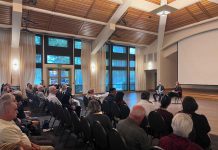Last week, dedicated workers and volunteers from more than 20 human service agencies brought food, clothing and services to unhoused people in South County.
Organized by the same committee that brought many services to the armory last February, this outreach was at Las Animas Park. Because it was outside, we discovered what we’ve found at other outdoor events elsewhere: that we reached more unhoused people outside than we did indoors (226 outside … 125 indoors at the armory). However, we found one thing this time in Gilroy that we didn’t find anywhere else: unhoused families with children living on the streets.
I wrote about this effort last February. Part of the county’s 10 Year Plan to End Chronic Homelessness, mandated by the federal government so the county can receive homeless assistance grant, this committee focuses on implementing the goals and objectives that focus on reaching out and engaging those who are chronically unhoused.
With this, we are trying to coordinate street-based outreach across the county. There are six programs in the county with personnel who go under bridges, into parks and along creek banks to reach those who are the hardest to serve and the most expensive if they remain in their current situation. The outreach workers learn the circumstances that lead them to this place in their lives, and what kind of road they’d need to take, in terms of accessing certain services and other steps, to come back and participate in our community in a healthy and
productive way.
We’re also trying to achieve a coordinated and seamless service system that supports these outreach workers. Once they make contact, then what? Folks living on the street need primary health care for health problems that result from living outside. They need links to benefits that help them obtain income to help them obtain housing. They need substance abuse and mental health treatment and job training, preparation and placement. Other than the mobile health vans from the county and Gardner Family Health Network, none of these systems are currently equipped to deal with the special needs of chronically unhoused people.
The main goal is to help them into permanent housing and support them afterward so they will stay there, and that’s the rub for us. A homeless person with benefits income is still homeless if he can’t find a place to accept the rent. We sometimes find units that will accept a subsidy but will not take the individual because of previous credit and legal problems (which, being part of the nature of chronic homelessness, afflicts 100 percent of this population).
The front line folks who donate their time or shift their caseloads to accommodate this volunteer effort are wonderful. However, we’re trying to make this a system change to meet the needs of these folks who were once brothers, sisters, employees, neighbors, friends, fathers, mothers and have fallen through the safety net and disappeared (or so it seems. They often wind up costing us much more money in the long run).
Turning my attention back to the event, of which we hope there will be many more until we know everyone who’s out here, who needs a home, and what it will take to get them there, there are very many people to recognize. The City of Gilroy’s efforts were headed by Community Development’s Marilyn Roaf. She provided a level of cooperation we’ve not seen yet from any other city. Gaeta’s Restaurant provided excellent food for St. Joseph Family Center to serve. All of Gavilan College’s cosmetology students were the hit of the party yet again. Local agencies Community Solutions, St. Joseph’s and Silicon Valley Independent Living Center, as well as the local county offices of Social Services Agency and Social Security Administration were joined by agencies from San Jose, Santa Clara and Mountain View. There are many, many more agencies and community volunteers who should be mentioned and for whom I have no room.
I must mention the folks, known to many in Gilroy, who live on the streets. They helped with intake; they helped direct their peers to services, as well as helped with set-up and cleanup. Grateful for the help and the attention, they gave as much as they took. This was just one of many glimpses they provide of the best of the human spirit, and it’s because of this that it’s worth the effort to help them become stable in housing, so we can benefit even more from their best actions and intentions.
Columnist Dina Campeau is a wife, mother of two teens and a resident of Morgan Hill. Her work for the last seven years has focused on affordable housing and homeless issues in Santa Clara County. Her column will be published each Friday. Reach her at dc******@*****er.net.







